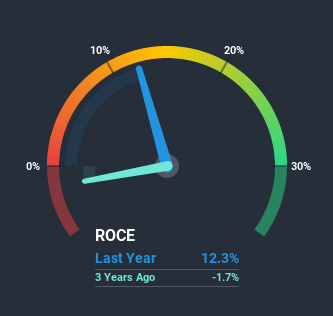If you're looking for a multi-bagger, there's a few things to keep an eye out for. Ideally, a business will show two trends; firstly a growing return on capital employed (ROCE) and secondly, an increasing amount of capital employed. Basically this means that a company has profitable initiatives that it can continue to reinvest in, which is a trait of a compounding machine. So when we looked at Hemisphere Energy (CVE:HME) and its trend of ROCE, we really liked what we saw.
Understanding Return On Capital Employed (ROCE)
For those that aren't sure what ROCE is, it measures the amount of pre-tax profits a company can generate from the capital employed in its business. To calculate this metric for Hemisphere Energy, this is the formula:
Return on Capital Employed = Earnings Before Interest and Tax (EBIT) ÷ (Total Assets - Current Liabilities)
0.12 = CA$6.7m ÷ (CA$56m - CA$1.2m) (Based on the trailing twelve months to September 2020).
Therefore, Hemisphere Energy has an ROCE of 12%. In absolute terms, that's a satisfactory return, but compared to the Oil and Gas industry average of 6.0% it's much better.
Check out our latest analysis for Hemisphere Energy

While the past is not representative of the future, it can be helpful to know how a company has performed historically, which is why we have this chart above. If you'd like to look at how Hemisphere Energy has performed in the past in other metrics, you can view this free graph of past earnings, revenue and cash flow.
So How Is Hemisphere Energy's ROCE Trending?
The fact that Hemisphere Energy is now generating some pre-tax profits from its prior investments is very encouraging. Shareholders would no doubt be pleased with this because the business was loss-making five years ago but is is now generating 12% on its capital. In addition to that, Hemisphere Energy is employing 80% more capital than previously which is expected of a company that's trying to break into profitability. This can indicate that there's plenty of opportunities to invest capital internally and at ever higher rates, both common traits of a multi-bagger.
In another part of our analysis, we noticed that the company's ratio of current liabilities to total assets decreased to 2.1%, which broadly means the business is relying less on its suppliers or short-term creditors to fund its operations. This tells us that Hemisphere Energy has grown its returns without a reliance on increasing their current liabilities, which we're very happy with.
What We Can Learn From Hemisphere Energy's ROCE
To the delight of most shareholders, Hemisphere Energy has now broken into profitability. Since the stock has returned a staggering 238% to shareholders over the last five years, it looks like investors are recognizing these changes. So given the stock has proven it has promising trends, it's worth researching the company further to see if these trends are likely to persist.
On a final note, we've found 2 warning signs for Hemisphere Energy that we think you should be aware of.
For those who like to invest in solid companies, check out this free list of companies with solid balance sheets and high returns on equity.
When trading Hemisphere Energy or any other investment, use the platform considered by many to be the Professional's Gateway to the Worlds Market, Interactive Brokers. You get the lowest-cost* trading on stocks, options, futures, forex, bonds and funds worldwide from a single integrated account. Promoted
Valuation is complex, but we're here to simplify it.
Discover if Hemisphere Energy might be undervalued or overvalued with our detailed analysis, featuring fair value estimates, potential risks, dividends, insider trades, and its financial condition.
Access Free AnalysisThis article by Simply Wall St is general in nature. It does not constitute a recommendation to buy or sell any stock, and does not take account of your objectives, or your financial situation. We aim to bring you long-term focused analysis driven by fundamental data. Note that our analysis may not factor in the latest price-sensitive company announcements or qualitative material. Simply Wall St has no position in any stocks mentioned.
*Interactive Brokers Rated Lowest Cost Broker by StockBrokers.com Annual Online Review 2020
Have feedback on this article? Concerned about the content? Get in touch with us directly. Alternatively, email editorial-team (at) simplywallst.com.
About TSXV:HME
Hemisphere Energy
Acquires, explores, develops, and produces petroleum and natural gas properties in Canada.
Flawless balance sheet, good value and pays a dividend.
Market Insights
Community Narratives



